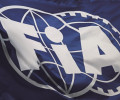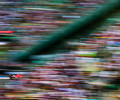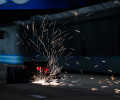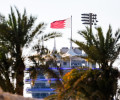2013 Singapore Grand Prix - Preview
18.09.13

|
|
|
|
|
Race Preview |
||
|
2013 SINGAPORE GRAND PRIX 20 - 22 SEPTEMBER 2013 |
||
|
The bright lights of the Marina Bay circuit provide the welcome this week as F1 heads east for the Singapore Grand Prix, the 13th round of the 2013 FIA Formula One World Championship. After the high-speed demands of Monza, the streets of Singapore offer a very different challenge. With 23 corners, unforgiving walls and a lap time longer than at any other current grand prix, Marina Bay demands ultimate concentration from drivers – but Singapore does everything it can to shake that concentration. Between the abundant undulations of the city boulevards, the glare of the lights, the high temperatures and the humidity, Singapore presents perhaps the sternest challenge of the racing year. Since joining the World Championship calendar in 2008, the Singapore Grand Prix has been won by just three drivers, who are also the three men leading the chase for the 2013 drivers’ title. Fernando Alonso won in 2008 and 2010, bracketing a win for Lewis Hamilton in 2009. The last two runnings of the race have seen Sebastian Vettel victorious. In 2012 Singapore marked the start of a four-race winning sequence for Vettel that saw him steadily diminish Alonso’s lead in the drivers’ championship. Vettel comes to Singapore this year in much better shape, off the back of wins in Belgium and Italy, both executed in imperious fashion. In doing so the reigning World Champion has established a lead of 53 points over Alonso and 81 over Hamilton. Vettel isn’t expected to have it quite so easy on the streets of Marina Bay. The strategic significance of track position, the ever-present threat of safety cars and forecast thunderstorms all contribute to make this grand prix potentially more complicated that those that have preceded it. |
 |
|
|
CIRCUIT DATA MARINA BAY CIRCUIT Length of lap: 5.073km Lap record: 1:45.599 (Kimi Raikkonen, Ferrari, 2008) Start/finish line offset: 0.137km Total number of race laps: 61 Total race distance: 309.316km Pitlane speed limits: 60km/h throughout the entire event weekend. CHANGES TO THE CIRCUIT SINCE 2012 ► Various small sections of track have been resurfaced. ► The steel kerbs installed for 2012 now have additional rear sections, removing the need to back-fill with asphalt (except the apex of Turn 18). ► The kerb on the exit of Turn Seven has been extended by 10m. ► Turn 10 has been re-aligned with the second and third apexes of the corner removed. ► The TecPro barrier on the exit of Turn 10 has been extended by 24m. DRS ZONES ► There will be two DRS zones. The detection point of the first is 230m before Turn Five with an activation point 50m after the apex of Turn Five. The second detection point is 80m before the apex of Turn 22 with activation 45m after the apex of Turn 23. |
||
|
|
||
 |
||
|
|
||
|
Singapore GP Fast Facts |
||
|
► The Singapore Grand Prix has always ran close to the two-hour maximum race time. The shortest Singapore Grand Prix to date was the 2009 race, won by Lewis Hamilton for McLaren in a time of 1:56:06.337. Fernando Alonso’s victories in 2008 and 2010 were both completed in 1h57m and Sebastian Vettel’s triumph in 2011 pushed that out to 1h59m. The 2012 race was the slowest to date with Vettel’s winning time recorded as 2:00:26.144. Having gone beyond the two-hour cut-off point, the chequered flag was waved after 59 laps on this occasion instead of the scheduled 61. This was the first time since 2008 a grand prix had been completed by duration rather than distance. ► The above statistic paints a slightly false picture, as the Singapore Grand Prix has never been allowed to go the distance at racing speeds. The safety car has appeared every year to slow down proceedings. The proximity of barriers and the difficulty in accessing the circuit to clear wreckage make this circuit a high-probability candidate for a safety car deployment – something race strategists have to factor into their calculations. |
► Despite being the grand prix that takes the longest to complete, Singapore has a higher average speed than Monaco. The disparity is explained by the Monaco Grand Prix running over a shorter distance than the rest of the calendar. ► In common with Monaco, Singapore is a maximum downforce circuit (and therefore sits at the opposite end of the scale to Monza). Other notable setup factors are necessitated by the uneven nature of the street surfaces and the need to attack kerbs through the tight right-angle street junctions. To address these issues, teams raise their ride-height and also set up with maximum suspension travel. ► The Formula One race is the second iteration of the Singapore Grand Prix. Its predecessor is a Formula Libre race which, having previously been called the Malaysian Grand Prix, became the Singapore Grand Prix after the city-state gained independence. The original incarnation of the Singapore Grand Prix ran from 1966-1973. |
► Over the five-race history of the modern Singapore Grand Prix, Sebastian Vettel, Fernando Alonso and Jenson Button are the only drivers to have completed every lap of every race. ► Despite the ever-present threat of rain in the tropics, and the frequent showers and thunderstorms that have preceded and followed the race, the Singapore Grand Prix has, to date, always been a dry race. ► Pirelli is bringing its Supersoft and Medium compounds to Singapore. This combination has been used in 2013 at the Australian and Canadian Grands Prix. As was the case in Montreal, Singapore is nominally going a step harder this year, Pirelli having allocated the Supersoft and Soft compounds in 2012 and 2011. |
|
|
||
|
Singapore GP Race Stewards Biographies |
||
|
PAUL GUTJAHR PRESIDENT OF THE FIA HILL CLIMB COMMISSION, BOARD MEMBER AND PRESIDENT OF AUTO SPORT SUISSE SARL |
 |
|
| Paul Gutjahr started racing in the late 1960s with Alfa Romeo, Lancia, Lotus and Porsche, then March in Formula 3. In the early ‘70s he became President of the Automobile Club Berne and organised numerous events. He acted as President of the organising committee of the Swiss GP at Dijon between 1980-82. Between 1980-2005 he acted as President of the Commission Sportive Nationale de l’Automobile Club de Suisse and in 2005 he became President and board member of the Auto Sport Suisse motor sports club. Gutjahr is President of the Alliance of European Hill Climb Organisers and has been steward at various high-level international competitions. He was the Formula 3000 Sporting Commissioner and has been a Formula One steward since 1995. | ||
|
|
||
|
VINCENZO SPANO PRESIDENT OF THE SPORTING COMMISSION OF THE AUTOMOBILE AND TOURING CLUB OF VENEZUELA |
 |
|
| Italian-born Vincenzo Spano grew up in Venezuela, where he went on to study at the Universidad Central de Venezuela, becoming an attorney-at-law. Spano has wide-ranging experience in motor sport, from national to international level. He has worked for the Touring y Automóvil Club de Venezuela since 1991, and served as President of the Sporting Commission since 2001. He was president for two terms and now sits as a member of the Board of the Nacam-FIA zone. Since 1995 Spano has been a licenced steward and obtained his FIA steward superlicence in 2003.Spano has been involved with the FIA and FIA Institute in various roles since 2001: a member of the World Motor Sport Council, the FIA Committee, and the executive committee of the FIA Institute. | ||
|
|
||
|
DEREK WARWICK FORMER FORMULA ONE DRIVER AND WORLD SPORTSCAR CHAMPION |
 |
|
| Derek Warwick raced in 146 grands prix from 1981 to 1993, appearing for Toleman, Renault, Brabham, Arrows and Lotus. He scored 71 points and achieved four podium finishes, with two fastest laps. He was World Sportscar Champion in 1992, driving for Peugeot. He also won Le Mans in the same year. He raced Jaguar sportscars in 1986 and 1991 and competed in the British Touring Car Championship between 1995 and 1998, as well as a futher appearance at the Le Mans in 1996, driving for the Courage Competition team. Warwick is a frequent FIA driver steward and is President of the British Racing Drivers’ Club. | ||
|
|
||
|
Singapore GP Championship Standings (Drivers) |
||
 |
||
|
|
||
|
Singapore GP Championship Standings (Constructors) |
||
 |
||
|
|
||
|
Singapore GP Formula One Timetable & FIA Media Schedule |
||
|
|
||
|
THURSDAY Press Conference FRIDAY Practice Session 1 Practice Session 2 Press Conference SATURDAY Practice Session 3 Qualifying Followed by unilateral and press conference SUNDAY Drivers' Parade Race Followed by podium interviews and press conference |
18.00 18.00-19.30 21.30-23.00 23.15 18.00-19.00 21.00-22.00 18.30 20.00 |
|
|
|
||
| ADDITIONAL MEDIA OPPORTUNITIES | ||
|
QUALIFYING All drivers eliminated in Q1 or Q2 are available for media interviews immediately after the end of each session, as are drivers who participated in Q3, but who are not required for the post-qualifying press conference. The TV pen is located close to the media centre entrance in the paddock. RACE Any driver retiring before the end of the race is available at the team’s garage/hospitality. In addition, during the race every team will make available at least one senior spokesperson for interview by officially accredited TV crews. A list of those nominated will be made available in the media centre. |
||

 Facebook
Facebook Twitter
Twitter





